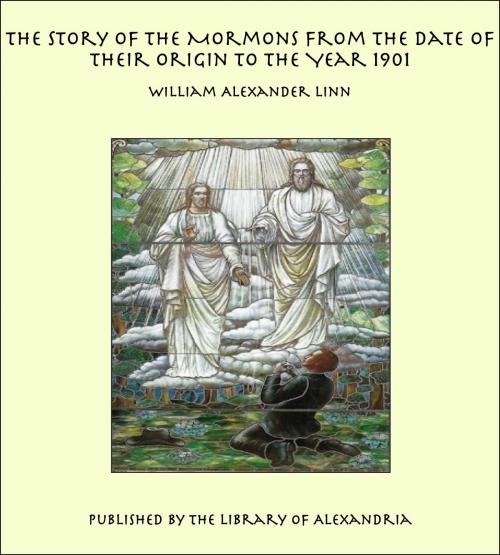The Story of the Mormons from the Date of Their Origin to the Year 1901
Nonfiction, Religion & Spirituality, New Age, History, Fiction & Literature| Author: | William Alexander Linn | ISBN: | 9781465547965 |
| Publisher: | Library of Alexandria | Publication: | March 8, 2015 |
| Imprint: | Language: | English |
| Author: | William Alexander Linn |
| ISBN: | 9781465547965 |
| Publisher: | Library of Alexandria |
| Publication: | March 8, 2015 |
| Imprint: | |
| Language: | English |
No chapter of American history has remained so long unwritten as that which tells the story of the Mormons. There are many books on the subject, histories written under the auspices of the Mormon church, which are hopelessly biased as well as incomplete; more trustworthy works which cover only certain periods; and books in the nature of "exposures" by former members of the church, which the Mormons attack as untruthful, and which rest, in the minds of the general reader, under a suspicion of personal bias. Mormonism, therefore, to-day suggests to most persons only one doctrine—polygamy—and only one leader—Brigham Young, who made his name familiar to the present generations. Joseph Smith, Jr., is known, where known at all, only in the most general way as the founder of the sect, while the real originator of the whole scheme for a new church and of its doctrines and government, Sidney Rigdon, is known to few persons even by name. The object of the present work is to present a consecutive history of the Mormons, from the day of their origin to the present writing, and as a secular, not as a religious, narrative. The search has been for facts, not for moral deductions, except as these present themselves in the course of the story. Since the usual weapon which the heads of the Mormon church use to meet anything unfavorable regarding their organization or leaders is a general denial, this narrative has been made to rest largely on Mormon sources of information. It has been possible to follow this plan a long way because many of the original Mormons left sketches that have been preserved. Thus we have Mother Smith's picture of her family and of the early days of the church; the Prophet's own account of the revelation to him of the golden plates, of his followers' early experiences, and of his own doings, almost day by day, to the date of his death, written with an egotist's appreciation of his own part in the play; other autobiographies, like Parley P. Pratt's and Lorenzo Snow's; and, finally, the periodicals which the church issued in Ohio, in Missouri, in Illinois, and in England, and the official reports of the discourses preached in Utah,—all showing up, as in a mirror, the character of the persons who gave this Church of Latter Day Saints its being and its growth. In regard to no period of Mormon history is there such a lack of accurate information as concerning that which covers their moves to Ohio, thence to Missouri, thence to Illinois, and thence to Utah. Their own excuse for all these moves is covered by the one word "persecution" (meaning persecution on account of their religious belief), and so little has the non-Mormon world known about the subject that this explanation has scarcely been challenged. Much space is given to these early migrations, as in this way alone can a knowledge be acquired of the real character of the constituency built up by Smith in Ohio, and led by him from place to place until his death, and then to Utah by Brigham Young. Any study of the aims and objects of the Mormon leaders must rest on the Mormon Bible ("Book of Mormon") and on the "Doctrine and Covenants," the latter consisting principally of the "revelations" which directed the organization of the church and its secular movements. In these alone are spread out the original purpose of the migration to Missouri and the instructions of Smith to his followers regarding their assumed rights to the territory they were to occupy; and without a knowledge of these "revelations" no fair judgment can be formed of the justness of the objections of the people of Missouri and Illinois to their new neighbors. If the fraudulent character of the alleged revelation to Smith of golden plates can be established, the foundation of the whole church scheme crumbles. If Rigdon's connection with Smith in the preparation of the Bible by the use of the "Spaulding manuscript" can be proved, the fraud itself is established. Considerable of the evidence on this point herein brought together is presented at least in new shape, and an adequate sketch of Sidney Rigdon is given for the first time. The probable service of Joachim's "Everlasting Gospel," as suggesting the story of the revelation of the plates, has been hitherto overlooked
No chapter of American history has remained so long unwritten as that which tells the story of the Mormons. There are many books on the subject, histories written under the auspices of the Mormon church, which are hopelessly biased as well as incomplete; more trustworthy works which cover only certain periods; and books in the nature of "exposures" by former members of the church, which the Mormons attack as untruthful, and which rest, in the minds of the general reader, under a suspicion of personal bias. Mormonism, therefore, to-day suggests to most persons only one doctrine—polygamy—and only one leader—Brigham Young, who made his name familiar to the present generations. Joseph Smith, Jr., is known, where known at all, only in the most general way as the founder of the sect, while the real originator of the whole scheme for a new church and of its doctrines and government, Sidney Rigdon, is known to few persons even by name. The object of the present work is to present a consecutive history of the Mormons, from the day of their origin to the present writing, and as a secular, not as a religious, narrative. The search has been for facts, not for moral deductions, except as these present themselves in the course of the story. Since the usual weapon which the heads of the Mormon church use to meet anything unfavorable regarding their organization or leaders is a general denial, this narrative has been made to rest largely on Mormon sources of information. It has been possible to follow this plan a long way because many of the original Mormons left sketches that have been preserved. Thus we have Mother Smith's picture of her family and of the early days of the church; the Prophet's own account of the revelation to him of the golden plates, of his followers' early experiences, and of his own doings, almost day by day, to the date of his death, written with an egotist's appreciation of his own part in the play; other autobiographies, like Parley P. Pratt's and Lorenzo Snow's; and, finally, the periodicals which the church issued in Ohio, in Missouri, in Illinois, and in England, and the official reports of the discourses preached in Utah,—all showing up, as in a mirror, the character of the persons who gave this Church of Latter Day Saints its being and its growth. In regard to no period of Mormon history is there such a lack of accurate information as concerning that which covers their moves to Ohio, thence to Missouri, thence to Illinois, and thence to Utah. Their own excuse for all these moves is covered by the one word "persecution" (meaning persecution on account of their religious belief), and so little has the non-Mormon world known about the subject that this explanation has scarcely been challenged. Much space is given to these early migrations, as in this way alone can a knowledge be acquired of the real character of the constituency built up by Smith in Ohio, and led by him from place to place until his death, and then to Utah by Brigham Young. Any study of the aims and objects of the Mormon leaders must rest on the Mormon Bible ("Book of Mormon") and on the "Doctrine and Covenants," the latter consisting principally of the "revelations" which directed the organization of the church and its secular movements. In these alone are spread out the original purpose of the migration to Missouri and the instructions of Smith to his followers regarding their assumed rights to the territory they were to occupy; and without a knowledge of these "revelations" no fair judgment can be formed of the justness of the objections of the people of Missouri and Illinois to their new neighbors. If the fraudulent character of the alleged revelation to Smith of golden plates can be established, the foundation of the whole church scheme crumbles. If Rigdon's connection with Smith in the preparation of the Bible by the use of the "Spaulding manuscript" can be proved, the fraud itself is established. Considerable of the evidence on this point herein brought together is presented at least in new shape, and an adequate sketch of Sidney Rigdon is given for the first time. The probable service of Joachim's "Everlasting Gospel," as suggesting the story of the revelation of the plates, has been hitherto overlooked















